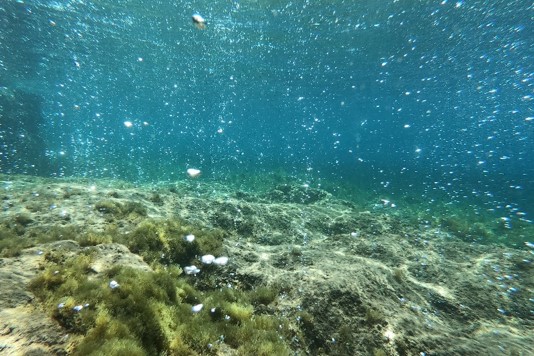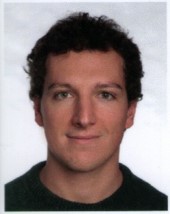 The laboratory of Geomicrobiology is equipped for the study of microbial processes that affect biogeochemical cycles. The available instrumentation allows the maintenance of cultures, the preparation of samples for incubation and their analysis for chemical composition, total alkalinity and dissolved gases.
The laboratory of Geomicrobiology is equipped for the study of microbial processes that affect biogeochemical cycles. The available instrumentation allows the maintenance of cultures, the preparation of samples for incubation and their analysis for chemical composition, total alkalinity and dissolved gases.
 |
|
For reservations please contact the Lab Manager
 |
Available instrumentation Soon available |
 |

ISSNP virtual school: 6th – 8th July 2021
We are glad to announce the 4th edition of the “International Summer School of Natural Products” (ISSNP)
As we are still experiencing Covid19-related restrictions, this edition will switch from physical to virtual school.
The school is designed for PhD students and young researchers and aimed to build up a lively scientific community tackling global challenges in the field of natural products.
Strategical objectives will be focused on interdisciplinary and intersectoral learning, networking and cross collaborations.
A combination of lectures, seminars and interactive sessions will provide an immersive and challenging experience and team-based problem-solving activities will help the participants to be prepared for future research studies in these fields
Applicants will learn from top scientists and professionals
In order to become a leader yourself, it is very important to learn from leaders. ISSNP attracts experts who are typically busy and rarely available during the academic year.
Applicants will be able to network with like-minded colleagues.
ISSNP is built around specific themes and targets students and researchers who have an interest in and enthusiasm for this special subject, Natural Products. Networks will be constructed throughout the 3 days of school activities, during lectures, seminars and interactive sessions, working in-group.
Positive aspects of Virtual Meetings:
• Meeting recordings ensure nothing goes lost
• You can meet on the go from your phone
• You can join from your favourite place
• You can create new workflows
• You can still talk face to face
• It’s easy to collaborate with screen sharing
• A big community online is even bigger
Registration
To register visit to the Registration Page for the IV Edition of the International Summer School on Natural Products (ISSNP) at https://www.issnpschool.org/registration/
The programme will be available at the link: issnpschool.org/programme/
Further information is available at the school website: https://www.issnpschool.org/school/
“BIAGIO ALBERTO DELLA BEFFA” PRIZE
On the occasion of the 100th Anniversary of its foundation, Indena (www.indena.com), in partnership with the International Summer School of Natural Products ISSNP, is pleased to announce the institution of a biennial prize dedicated to the memory of its founder “Biagio Alberto Della Beffa.”
For the first edition of the “Biagio Alberto Della Beffa” Prize, three contest winners will be selected among the next International Summer School of Natural Product edition participants. The prize aims to award and support the professional development of young talented scientists in Natural Product Chemistry.
The prize is directed to Chemists, Pharmacists, and Pharmaceutical Chemists who obtained their MSc after 2018 and are currently attending the 2nd/3rd year of a PhD related to Chemistry and Pharmaceutical Sciences.
The three winners will be awarded a Grant of 5.000,00 €, and they will benefit of a 6-month internship at Indena’s premises, that includes a Managerial course.
The prize will be awarded during the International Summer School on Natural Products, organized among the 6th and the 8th July 2021, signifying a closer collaboration between Industry and Academia.
Kindly feel free to contact us (This email address is being protected from spambots. You need JavaScript enabled to view it.) for any further queries.
Scientific committee
Valeria COSTANTINO, President (Università degli Studi di Napoli Federico II)
Alessia CASO (Università degli Studi di Napoli Federico II)
Adele CUTIGNANO (Istituto di chimica biomolecolare, CNR)
Gerardo Della Sala (Stazione Zoologica, Anton Dohrn)
Germana ESPOSITO (Università degli Studi di Napoli Federico II)
Gabriele FONTANA (Indena)
Roberta MARCHETTI (Università degli Studi di Napoli Federico II)
Luigi MILELLA (Università degli Studi della Basilicata)
Alberto MINASSI (Università degli Studi del Piemonte Orientale)
Maria Chiara MONTI (Università degli Studi di Salerno)
Mattia MORI (Università degli Studi di Siena)
Vera MUCCILLI (Università degli Studi di Catania)
Giorgia OLIVIERO (Università degli Studi di Napoli Federico II)
Daniele PASSARELLA (Università degli Studi di Milano)
Giovanna ROMANO (Stazione Zoologica, Anton Dohrn)
Valentina SEPE (Università degli Studi di Napoli Federico II)
Advisory Board
William GERWICK (Department of Biology and Marine Biology and Center for Marine Science, UNCW)
Mark BRÖNSTRUP (Centre for Drug Research, Faculty of Pharmacy, University of Helsinki)
Patrícia VALENTÃO (Faculty of Pharmacy, University of Porto).
Higher Education
- Gabriella Grossi, Coordinator
Grant Innovation Office (GIO)
Naples
- Giorgio Carpino, Coordinator
- Alberto Corona
- Ornella Papaluca
- Giosuè Zurzolo
Rome
Institutional communication
NO affilations
Albarano L, Zupo V, Caramiello D, Toscanesi M, Trifuoggi M, Guida M, Libralato G, & Costantini M (2021) Sub-Chronic Effects of Slight PAH- and PCB-Contaminated Mesocosms in Paracentrotus lividus Lmk: A Multi-Endpoint Approach and De Novo Transcriptomic. International Journal of Molecular Sciences 22(13):6674. https://doi.org/10.3390/ijms22136674
Albarano L, Zupo V, Guida M, Libralato G, Caramiello D, Ruocco N, & Costantini M (2021) PAHs and PCBs Affect Functionally Intercorrelated Genes in the Sea Urchin Paracentrotus lividus Embryos. International Journal of Molecular Sciences 22(22):12498. https://doi.org/10.3390/ijms222212498
Andretta E, Costa C, Longobardi C, Damiano S, Giordano A, Pagnini F, Montagnaro S, Quintiliani M, Lauritano C, & Ciarcia R (2021) Potential Approaches Versus Approved or Developing Chronic Myeloid Leukemia Therapy. Frontiers in Oncology 11(5087). https://doi.org/10.3389/fonc.2021.801779
Ausuri J, Vitale GA, Coppola D, Palma Esposito F, Buonocore C, & de Pascale D (2021) Assessment of the Degradation Potential and Genomic Insights towards Phenanthrene by Dietzia psychralcaliphila JI1D. Microorganisms 9(6):1327. https://doi: 10.3390/microorganisms9061327
Balzano S, Jamieson T, & Leterme S (2021) Changes in microbial communities during seawater pre-treatment within a desalination plant. Aquatic Microbial Ecology 86:63-68. https://doi.org/10.3354/ame01958
Bazzani E, Lauritano C, Mangoni O, Bolinesi F, & Saggiomo M (2021) Chlamydomonas Responses to Salinity Stress and Possible Biotechnological Exploitation. Journal of Marine Science and Engineering 9(11):1242. https://doi.org/10.3390/jmse9111242
Blasio M & Balzano S (2021) Fatty Acids Derivatives From Eukaryotic Microalgae, Pathways and Potential Applications. Frontiers in Microbiology 12(2689). https://www.frontiersin.org/articles/10.3389/fmicb.2021.718933/full
Coppola D, Lauritano C, Palma Esposito F, Riccio G, Rizzo C, & de Pascale D (2021) Fish Waste: From Problem to Valuable Resource. Marine Drugs 19(2):116. doi: 10.3390/md19020116.
Dell’Anno F, Rastelli E, Tangherlini M, Corinaldesi C, Sansone C, Brunet C, Balzano S, Ianora A, Musco L, Montereali MR, & Dell’Anno A (2021) Highly Contaminated Marine Sediments Can Host Rare Bacterial Taxa Potentially Useful for Bioremediation. Frontiers in Microbiology 12(326). https://doi.org/10.3389/fmicb.2021.584850
Di Costanzo F, Di Dato V, van Zyl LJ, Cutignano A, Esposito F, Trindade M, & Romano G (2021) Three Novel Bacteria Associated with Two Centric Diatom Species from the Mediterranean Sea, Thalassiosira rotula and Skeletonema marinoi. International Journal of Molecular Sciences 22(24):13199.https://doi.org/10.3390/ijms222413199
Giordano D, Corti P, Coppola D, Altomonte G, Xue J, Russo R, di Prisco G, & Verde C (2021). Regulation of globin expression in Antarctic fish under thermal and hypoxic stress. Marine Genomics 57:100831. https://doi.org/10.1016/j.margen.2020.100831
Gregorin C, Albarano L, Somma E, Costantini M, Zupo V (2021) Assessing the Ecotoxicity of Copper and Polycyclic Aromatic Hydrocarbons: Comparison of Effects on Paracentrotus lividus and Botryllus schlosseri, as Alternative Bioassay Methods. Water 13: 711. https://doi.org/10.3390/w13050711
Horchani M, Della Sala G, Caso A, D’Aria F, Esposito G, Laurenzana I, Giancola C, Costantino V, Jannet HB, & Romdhane A (2021) Molecular Docking and Biophysical Studies for Antiproliferative Assessment of Synthetic Pyrazolo-Pyrimidinones Tethered with Hydrazide-Hydrazones. International Journal of Molecular Sciences 22(5):2742. https://doi.org/10.3390/ijms22052742
Jamieson T, Balzano S, Le Lan C, Kildea T, Ellis AV, Brown MH, & Leterme SC (2021) Survival of the fittest: Prokaryotic communities within a SWRO desalination plant. Desalination 514:115152. https://doi.org/10.1016/j.desal.2021.115152
Lattaud J, Balzano S, van der Meer MTJ, Villanueva L, Hopmans EC, Sinninghe Damsté JS, & Schouten S (2021) Sources and seasonality of long-chain diols in a temperate lake (Lake Geneva). Organic Geochemistry 156:104223. https://doi.org/10.1016/j.orggeochem.2021.104223
Lauritano C & Saide A (2021) Editorial of Special Issue "Microalgal Molecules and Enzymes". International Journal of Molecular Sciences 22(24):13450. https://doi.org/10.3390/ijms222413450
Levy T, Zupo V, Mutalipassi M, Somma E, Ruocco N, Costantini M, Abehsera S, Manor R, Chalifa-Caspi V, Sagi A, & Aflalo ED (2021) Protandric Transcriptomes to Uncover Parts of the Crustacean Sex-Differentiation Puzzle. Frontiers in Marine Science 8(1487). https://doi.org/10.3389/fmars.2021.745540
Mutalipassi M, Riccio G, Mazzella V, Galasso C, Somma E, Chiarore A, de Pascale D, & Zupo V (2021) Symbioses of Cyanobacteria in Marine Environments: Ecological Insights and Biotechnological Perspectives. Marine Drugs 19(4):227. https://doi.org/10.3390/md19040227
Roncalli V, Lauritano C, & Carotenuto Y (2021) First Report of OvoA Gene in Marine Arthropods: A New Candidate Stress Biomarker in Copepods. Marine Drugs 19(11):647. https://doi.org/10.3390/md19110647
Ruocco N, Esposito R, Bertolino M, Zazo G, Sonnessa M, Andreani F, Coppola D, Giordano D, Nuzzo G, Lauritano C, Fontana A, Ianora A, Verde C, Costantini M (2021) A Metataxonomic Approach Reveals Diversified Bacterial Communities in Antarctic Sponges. Marine Drugs 19: 173. https://doi.org/10.3390/md19030173
Ruocco N, Esposito R, Zagami G, Bertolino M, De Matteo S, Sonnessa M, Andreani F, Crispi S, Zupo V, & Costantini M (2021) Microbial diversity in Mediterranean sponges as revealed by metataxonomic analysis. Scientific Reports 11(1):21151. https://doi.org/10.1038/s41598-021-00713-9
Sabatino V, Orefice I, Marotta P, Ambrosino L, Chiusano ML, d'Ippolito G, Romano G, Fontana A, & Ferrante MI (2021) Silencing of a Pseudo-nitzschia arenysensis lipoxygenase transcript leads to reduced oxylipin production and impaired growth. New Phytologist. https://doi.org/10.1111/nph.17739
Saide A, Damiano S, Ciarcia R, & Lauritano C (2021) Promising Activities of Marine Natural Products against Hematopoietic Malignancies. Biomedicines 9(6):645. https://doi.org/10.3390/biomedicines9060645
Saide A, Lauritano C, & Ianora A (2021) A Treasure of Bioactive Compounds from the Deep Sea. Biomedicines 9(11):1556. https://doi.org/10.3390/biomedicines9111556
Sardo A, Orefice I, Balzano S, Barra L, & Romano G (2021) Mini-Review: Potential of Diatom-Derived Silica for Biomedical Applications. Applied Sciences 11(10):4533. https://doi.org/10.3390/app11104533
Tedesco P, Palma Esposito F, Masino A, Vitale GA, Tortorella E, Poli A, Nicolaus B, van Zyl LJ, Trindade M, & de Pascale D (2021) Isolation and Characterization of Strain Exiguobacterium sp. KRL4, a Producer of Bioactive Secondary Metabolites from a Tibetan Glacier. Microorganisms 9(5):890. doi: 10.3390/microorganisms9050890.
Teta R, Sala GD, Esposito G, Stornaiuolo M, Scarpato S, Casazza M, Anastasio A, Lega M, & Costantino V (2021) Monitoring Cyanobacterial Blooms during the COVID-19 Pandemic in Campania, Italy: The Case of Lake Avernus. Toxins 13(7):471. https://doi.org/10.3390/toxins13070471
Funari V, Gomes HI, Coppola D, Vitale GA, Dinelli E, de Pascale D, & Rovere M (2021) Opportunities and threats of selenium supply from unconventional and low-grade ores: A critical review. Resources, Conservation and Recycling 170:105593.https://doi.org/10.1016/j.resconrec.2021.105593
Zou Y, Tortorella E, Robbens J, Heyndrickx M, Debode J, De Pascale D, & Raes K (2021) Bioactivity Screening of Hydrolysates From Brown Crab Processing Side Streams Fermented by Marine Pseudoalteromonas Strains. Waste and Biomass Valorization 12(5):2459-2468. https://doi.org/10.1007/s12649-020-01195-y
Zannella C, Giugliano R, Chianese A, Buonocore C, Vitale GA, Sanna G, Sarno F, Manzin A, Nebbioso A, Termolino P, Altucci L, Galdiero M, de Pascale D, & Franci G (2021) Antiviral Activity of Vitis vinifera Leaf Extract against SARS-CoV-2 and HSV-1. Viruses 13(7):1263. doi: 10.3390/v13071263.










